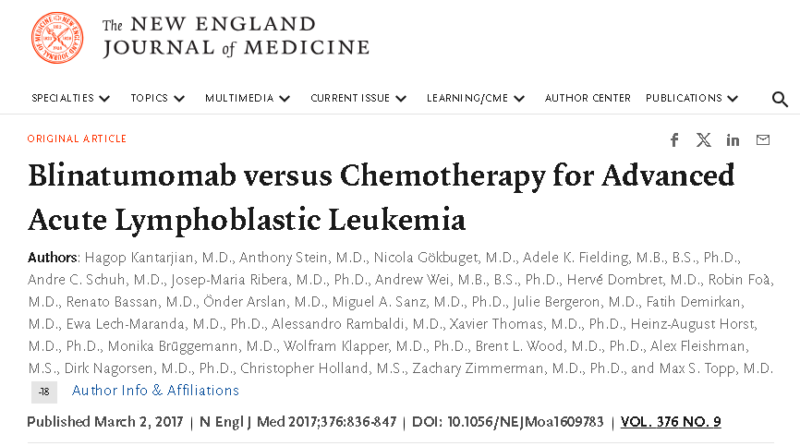Mark Geyer, Assistant Professor Of Medicine at Weill Cornell Medicine, shared on X about a recent paper by Hagop Kantarjian et al. titled “Blinatumomab versus Chemotherapy for Advanced Acute Lymphoblastic Leukemia” published in The New England Journal of Medicine.
Authors: Hagop Kantarjian, Anthony Stein, Nicola Gökbuget, Adele Fielding, Andre Schuh et al.

“A few days late, but wanted to post about the practice-changing ECOG 1910 trial led by my colleague Mark Litzow. The bispecific T-cell engager (BiTE) blinatumomab (blina) comprises two scFVs directed to CD3 (on T-cells) and CD19 (on malignant and non-malignant B-cells).
Blina was first approved for relapsed/refractory B-ALL based on the randomized TOWER trial.
Subgroup analysis from that study suggested better rates of response and OS in patients with lower-burden (vs higher burden) all.

Subsequently, results from the BLAST trial in patients with 0.1%-<5% B-ALL after 3 courses of intensive chemotherapy supported efficacy in clearing measurable residual disease (MRD), with some long-term responses even seen without subsequent allogeneic transplant, further supporting the role of blina in patients with low-volume disease.
So blina is effective for patients with frank R/R B-ALL and those who are MRD+. But what about MRD-negative?
ECOG 1910 was a randomized trial of patients age 30-70 with BCR::ABL1-negative B-ALL and primary analysis ultimately focused on patients who were MRD negative after induction 1/2 and intensification, randomized to chemo alone vs chemo + blina.
Litzow et al. have now demonstrated an Overall Survival benefit in patients with B-ALL achieving MRD negativity who received blina in CR1 (85% vs 68% OS at 3y, 80% vs 64% RFS at 3y).
The chemo backbone of E1910 is less-than-attractive to some (including me) but the 16-17% advantage in RFS/OS is striking and practice-changing.
How should we incorporate blina into pediatric regimens such as CALGB 10403 (Link) and pediatric inspired regimens? (Link) Can we remove blocks of intensive chemo? And what about SC blina to spare the need for a central line?
This still needs to be addressed (and hopefully will be soon), but for now, congrats to the E1910 team for conclusively showing benefits of blina even in sub-MRD-level disease!”
Source: Mark Geyer/X
